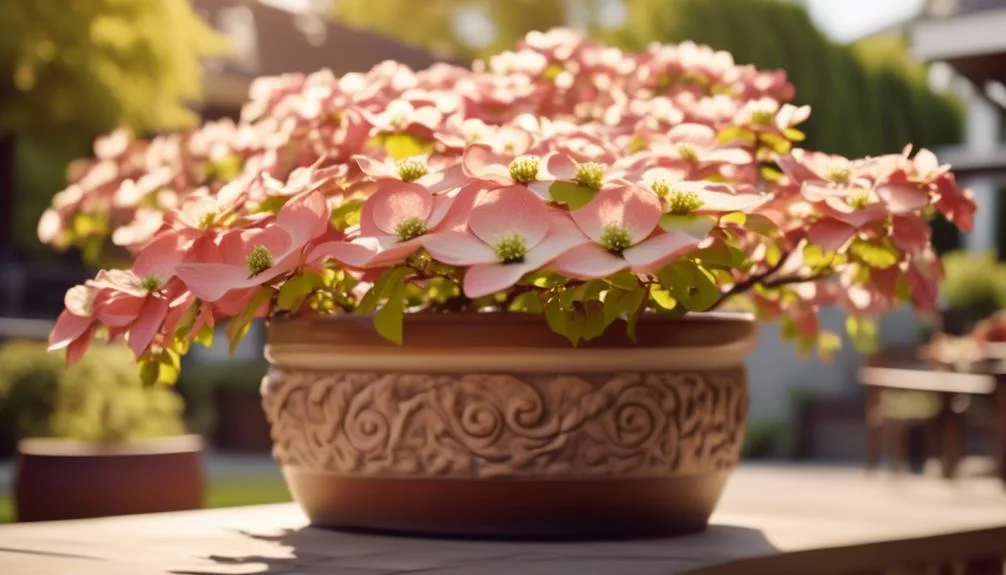Dreaming of a stunning dogwood tree on your balcony? Wondering if it can thrive in a pot?
Surprisingly, dogwood trees can be grown in containers, bringing nature's beauty to your urban space.
But before you rush to buy one, there are important factors to consider for its thriving. Dogwoods are known for sprawling gardens, but with the right care, you can enjoy one on your own patio.
Suitable Dogwood Varieties for Container Growing
When choosing suitable dogwood varieties for container growing, consider the compact size and adaptability of the 'Stellar Pink' and 'Cherokee Brave' cultivars. These varieties are well-suited for container growth due to their manageable size and stunning blooms.
When it comes to pruning techniques, it's essential to regularly remove dead or diseased branches to maintain the health and aesthetics of the tree. Additionally, light pruning can be done in late winter to promote a more compact growth habit.
As for propagation methods, dogwoods can be propagated through both seeds and softwood cuttings. However, propagating from cuttings is often preferred as it allows for the retention of the parent plant's characteristics.
Choosing the Right Container for Dogwood Trees
To continue on the topic of growing dogwood trees in pots, it's essential to consider the right container for your dogwood trees.
When choosing a container for your dogwood tree, consider the size of the container. The ideal container size should be at least 2 feet deep and 2 feet wide to accommodate the tree's root system. A larger container will provide more room for the roots to spread and support the tree's growth.
Additionally, it's crucial to ensure that the chosen container has a proper drainage system. Adequate drainage is essential to prevent waterlogging, which can lead to root rot and other issues. Look for containers with drainage holes at the bottom to allow excess water to escape, promoting healthy root development and overall tree health.
Soil and Water Requirements for Dogwood Trees in Pots
For successful growth of dogwood trees in pots, ensure that the soil and watering are meticulously managed to provide the ideal conditions for your tree's health and development. When it comes to soil and water requirements for dogwood trees in pots, here are essential factors to consider:
- Container Size: Choose a pot that's at least 2 feet deep and wide to allow for proper root development.
- Soil Quality: Use well-draining, acidic soil mix to mimic the tree's natural habitat.
- Watering: Maintain consistent moisture levels by watering when the top inch of soil feels dry.
- Fertilizer Needs: Use a balanced, slow-release fertilizer to provide essential nutrients throughout the growing season.
- Mulching: Apply a layer of organic mulch to retain moisture and regulate soil temperature.
Proper Care and Maintenance for Potted Dogwood Trees
Properly caring for potted dogwood trees is essential for ensuring their healthy growth and long-term success. When it comes to pruning techniques, it's important to regularly remove dead or damaged branches to promote new growth and maintain a pleasing shape. Prune your potted dogwood tree during its dormant season to minimize stress.
As for fertilizer needs, a balanced, slow-release fertilizer in spring can provide essential nutrients for healthy foliage and blooms. Look for a fertilizer specifically formulated for trees and shrubs, and follow the application instructions to avoid over-fertilization. Remember to water the tree thoroughly after applying fertilizer.
Potential Challenges of Growing Dogwood Trees in Pots
Experienced gardeners often encounter challenges when growing dogwood trees in pots, requiring careful attention to ensure the trees' health and vitality. When cultivating dogwood trees in containers, several potential issues may arise:
- Root Space: Dogwood trees have extensive root systems, and when grown in pots, they may become root-bound, leading to stunted growth and decreased vitality.
- Drainage Issues: Inadequate drainage can result in waterlogged soil, causing root rot and other health problems for the tree.
- Nutrient Deficiency: Potted dogwood trees may experience nutrient deficiencies due to limited access to soil nutrients.
- Temperature Regulation: Containers can make it challenging to regulate soil temperature, potentially affecting the tree's overall health.
- Watering Management: Maintaining proper moisture levels can be tricky in pots, as they can dry out quickly or become oversaturated, impacting the tree's well-being.
Successfully addressing these challenges is crucial for the thriving growth of dogwood trees in pots.
Conclusion
In nurturing potted dogwood trees, embracing the right variety, container, soil, and attentive care is the key to flourishing beauty in your outdoor sanctuary.
Stay mindful of potential challenges, and let your dedication blossom alongside their graceful presence.
Happy gardening!

My interest in trees started when I first saw the giant sequoias in Yosemite.
I was a teenager then, and I remember thinking, “I need to learn more about this.”
That moment stuck with me.
A few years later, I went on to study forestry at Michigan Tech.
Since graduating, I’ve worked in a mix of hands-on tree care and community education.
I’ve spent over ten years helping people understand how to plant, maintain, and protect the trees in their neighborhoods.
I don’t see trees as just part of the landscape.
They are living things that make a real difference in our daily lives.
